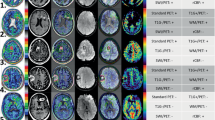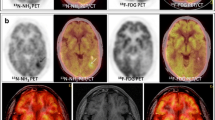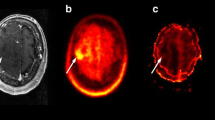Abstract
To evaluate diagnostic accuracy of perfusion weighted imaging (PWI) and positron emission tomography (PET) using an integrated PET/MR system in tumor grading as well as in differentiating recurrent tumor from treatment-induced effects (TIE) in brain tumor patients. Twenty patients (Group A: treatment naïve, 9 patients with 16 lesions; Group B: post-therapy, 11 patients with 18 lesions) underwent fluorine 18 (18F) fluorodeoxyglucose (FDG) brain PET/MR with PWI. Two blinded readers predicted low versus high-grade tumor (for Group A) and tumor recurrence versus TIE (for Group B) based solely on tumor rCBV (regional cerebral blood volume) and SUV (standardized uptake values). Tumor histopathology at resection was the reference standard. Using rCBVmean ≤ 1.74 as a cut-off, 100 % sensitivity and 74 % specificity were observed, whereas 75 % sensitivity and 89.7 % specificity were observed with SUVmean ≤ 4.0 as a cut-off to classify patients as test positive for low-grade tumors (Group A) and TIE (Group B). Diagnostic accuracy for detection of low-grade tumors was 90 % using PWI and 40 % using PET in Group A (p = 0.056); for detection of TIE in Group B, diagnostic accuracy was 94.1 % using PWI and 55.6 % using PET (p = 0.033). No significant correlation was demonstrated between rCBV parameters and SUV in Group A (mean values: p > 0.403), Group B (p > 0.06) and in the entire population (p > 0.07). Best overall sensitivity and specificity were obtained using rCBVmean ≤ 1.74 and SUVmean ≤ 4.0 cut-off values. PWI demonstrated better diagnostic accuracy in both groups. Poor correlation was observed between FDG and rCBV parameters.



Similar content being viewed by others
References
Griffith B, Jain R (2015) Perfusion imaging in neuro-oncology: basic techniques and clinical applications. Radiol Clin North Am 53(3):497–511
Partovi S, Kohan A, Rubbert C et al (2014) Clinical oncologic applications of PET/MRI: a new horizon. Am J Nucl Med Mol Imaging 4(2):202–212
Segtnan EA, Hess S, Grupe P et al (2015) 18F-fluorodeoxyglucose PET/computed tomography for primary brain tumors. PET Clin 10(1):59–73
Demetriades AK, Almeida AC (2014) Bhangoo RS Applications of positron emission tomography in neuro-oncology: a clinical approach. Surgeon 12(3):148–157
Wong TZ, van der Westhuizen GJ, Coleman RE (2002) Positron emission tomography imaging of brain tumors. Neuroimaging Clin N Am 12(4):615–626
Tian J, Fu L, Yin D et al (2014) Does the novel integrated PET/MRI Offer the same diagnostic performance as PET/CT for oncological indications? Plos One 9(6):e90844
Hofmann M, Pichler B, Scholkopf B et al (2009) Towards quantitative PET/MRI: a review of MR-baed attenuation correction techniques. Eur J Nucl Med Mol Imaging 36:S93–S104
Keller SH, Holm S, Hansen AE et al (2013) Image artifacts from MR-based attenuation correction in clinical, whole body PET/MRI. MAGMA 39:1519–1524
Filss CP, Galldiks N, Stoffels G et al (2014) Comparison of 18F-FET PET and perfusion-weighted MR imaging: a PET/MR imaging hybrid study in patients with brain tumors. J Nucl Med 55(4):540–545
Kim YH, Oh SW, Lim YJ et al (2010) Differentiating radiation necrosis from tumor recurrence in high-grade gliomas: assessing the efficacy of 18F-FDG PET, 11C-methionine PET and perfusion MRI. Clin Neurol Neurosurg 112(9):758–765
Hatzoglou V, Ulaner GA, Zhang Z, Beal K, Holodny AI, Young RJ (2013) Comparison of the effectiveness of MRI perfusion and fluorine-18 FDG PET-CT for differentiating radiation injury from viable brain tumor: a preliminary retrospective analysis with pathologic correlation in all patients. Clin Imaging 37(3):451–457
Aronen HJ, Gazit IE et al (1994) Cerebral blood volume maps of gliomas: comparison with tumor grade and histologic findings. Radiology 191(1):41–51
Knopp EA, Cha S, Johnson G (1999) Glial neoplasms: dynamic contrast-enhanced T2*-weighted MR imaging. Radiology 211(3):791–798
Sugahara T, Korogi Y, Kochi M (1998) Correlation of MR imaging-determined cerebral blood volume maps with histologic and angiographic determination of vascularity of gliomas. AJR Am J Roentgenol 171(6):1479–1486
Arvinda HR, Kesavadas C, Sarma ps (2009) Glioma grading: sensitivity, specificity, positive and negative predictive values of diffusion and perfusion imaging. J Neurooncol 94(1):87–96
Sugahara T, Korogi Y, Tomiguchi S (2000) Posttherapeutic intraaxial brain tumor: the value of perfusion-sensitive contrast-enhanced MR imaging for differentiating tumor recurrence from nonneoplastic contrast-enhancing tissue. AJNR Am J Neuroradiol 21(5):901–909
Forsyth PA, Kelly PJ, Cascino TL (1995) Radiation necrosis or glioma recurrence: is computer-assisted stereotactic biopsy useful? J Neurosurg 82(3):436–444
Prat R, Galeano I, Lucas A, Martínez JC, Martín M, Amador R, Reynés G (2010) Relative value of magnetic resonance spectroscopy, magnetic resonance perfusion, and 2-(18F) fluoro-2-deoxy-d-glucose positron emission tomography for detection of recurrence or grade increase in gliomas. J Clin Neurosci 17(1):50–53
Herholz K, Langen KJ, Schiepers C, Mountz JM (2012) Brain tumors. Semin Nucl Med 42:356–370
Dunet V, Pomoni A, Hottinger A, Nicod-Lalonde M, Prior JO (2015) Performance of 18F-FET versus 18F-FDG-PET for the diagnosis and grading of brain tumors: systematic review and meta-analysis. Neuro Oncol. doi:10.1093/neuonc/nov148
Li Z, Yu Y, Zhang H, Xu G, Chen L (2015) A meta-analysis comparing 18F-FLT PET with 18F-FDG PET for assessment of brain tumor recurrence. Nucl Med Commun 36(7):695–701
Dankbaar JW, Snijders TJ, Robe PA, Seute T, Eppinga W, Hendrikse J, De Keizer B (2015) The use of (18)F-FDG PET to differentiate progressive disease from treatment induced necrosis in high gradeglioma. J Neurooncol 125(1):167–175
Barajas RF Jr, Phillips JJ, Parvataneni R et al (2012) Regional variation in histopathologic features of tumor specimens from treatment-naive glioblastoma correlates with anatomic and physiologic MR Imaging. Neuro Oncol 14(7):942–954
Maia AC Jr, Malheiros SM, da Rocha AJ et al (2005) MR cerebral blood volume maps correlated with vascular endothelial growth factor expression and tumor grade in nonenhancing gliomas. AJNR Am J Neuroradiol 26(4):777–783
Sadeghi N, D’Haene N, Decaestecker C et al (2008) Apparent diffusion coefficient and cerebral blood volume in brain gliomas: relation to tumor cell density and tumor microvessel density based on stereotactic biopsies. AJNR Am J Neuroradiol 29(3):476–482 Epub 2007 Dec 13
Galbán CJ, Chenevert TL, Meyer CR et al (2011) Prospective analysis of parametric response map-derived MRI biomarkers: identification of early and distinct glioma response patterns not predicted by standard radiographic assessment. Clin Cancer Res 17(14):4751–4760
Tsien C, Galbán CJ, Chenevert TL (2010) Parametric response map as an imaging biomarker to distinguish progression from pseudoprogression in high-grade glioma. J Clin Oncol 28(13):2293–2299
Dhermain FG, Hau P, Lanfermann H et al (2010) Advanced MRI and PET imaging for assessment of treatment response in patients with gliomas. Lancet Neurol 9:906–920
Zukotynski KA, Fahey FH, Vajapeyam S et al (2013) Exploratory evaluation of MR permeability with 18F-FDG PET mapping in pediatric brain tumors: a report from the pediatric brain tumor consortium. J Nucl Med 54:1237–1243
Ozsunar Y, Mullins ME, Kwong K et al (2010) Glioma recurrence versus radiation necrosis? A pilot comparison of arterial spin-labeled, dynamic susceptibility contrast enhanced MRI, and FDG-PET imaging. Acad Radiol 17:282–290
Acknowledgments
Work principally supported by CAI2R and/or performed by CAI2R personnel. The Center for Advanced Imaging Innovation and Research (CAI2R, www.cai2r.net) at New York University School of Medicine is supported by NIH/NIBIB Grant number P41 EB017183.
Author information
Authors and Affiliations
Corresponding author
Ethics declarations
Conflict of interest
No conflict of interest pertaining to the subject matter of this manuscript.
Rights and permissions
About this article
Cite this article
Sacconi, B., Raad, R.A., Lee, J. et al. Concurrent functional and metabolic assessment of brain tumors using hybrid PET/MR imaging. J Neurooncol 127, 287–293 (2016). https://doi.org/10.1007/s11060-015-2032-6
Received:
Accepted:
Published:
Issue Date:
DOI: https://doi.org/10.1007/s11060-015-2032-6




